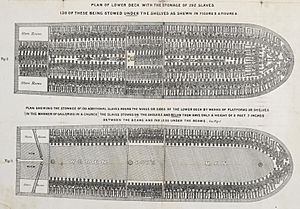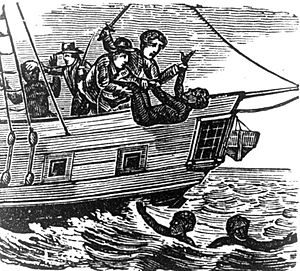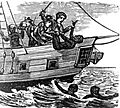William Gregson (slave trader) facts for kids
William Gregson (born 1721 – died 1800) was a British man who made his fortune by trading in enslaved people. He was involved in at least 152 voyages that carried people from Africa to other parts of the world to be sold. Records show his ships carried 58,201 Africans. Sadly, 9,148 of these people died during the journeys. Gregson was also a co-owner of a ship called the Zong. The crew of this ship committed a terrible act known as the Zong massacre.
Contents
Early Life of William Gregson
William Gregson was born in Liverpool, England, on January 12, 1721. When he was young, he worked as a rope maker.
What Was the Slave Trade?
William Gregson became one of Britain's busiest slave traders. He completed at least 152 voyages. Only two other slave traders from Liverpool had more recorded trips. These were William Boats with 157 voyages and William Davenport with 155.
Gregson's ships carried 58,201 people from Africa. Of these, 9,148 died on board. Gregson's ships followed the Atlantic slave trade route. This route involved three main parts:
- Ships left Liverpool with goods like cloth and metal.
- These goods were traded for enslaved people in Africa.
- The enslaved people were then taken across the Atlantic Ocean. They were sold in places like the Caribbean or Spanish America.
- Finally, the ships returned to Liverpool. They carried goods like cotton, sugar, or spices.
More than half of the enslaved people Gregson transported came from the Bight of Biafra. This area is now part of the Gulf of Guinea. Over 40% of these people were taken to Jamaica.
The Horrific Zong Massacre
On November 29, 1781, something terrible happened on the slave ship Zong. The crew began throwing the enslaved people into the sea. More than 130 enslaved people died. This awful event became known as the Zong massacre.
The Zong ship was owned by a group of slave traders. William Gregson was the leader of this group. His two sons, John and James Gregson, were also owners. So was his son-in-law, George Case, along with Edward Wilson and James Aspinall.
After the massacre, the owners tried to claim insurance money. They asked for £30 for each person who had been killed. The insurance company refused to pay. This led to a court case. The owners first won their case. However, the decision was later changed on appeal. The judge, Lord Mansfield, said that "the Case of Slaves was the same as if Horses had been thrown overboard." This meant he saw enslaved people as property, not as human beings.
Even though the court case did not punish the owners, the Zong massacre was very important. It helped to turn public opinion against slavery. The event showed how cruel slave traders could be. It highlighted the planned murder of innocent enslaved Africans.
William Gregson: Lord Mayor of Liverpool
Liverpool was the most important city in Britain for the slave trade. At least twenty-five Lord Mayors of Liverpool were slave traders. William Gregson became Lord Mayor in 1762. His son, John Gregson, who was also a slave trader, became Lord Mayor in 1784.
By 1787, people started to speak out against the slave trade. This was called the abolition movement. The Liverpool Council became worried about this movement. They asked Parliament not to make rules against the slave trade. In 1788, the Liverpool Council told Parliament that the trade had been carried on for centuries. They said it brought many benefits to the country. They also claimed it was "unjustly reprobated as impolitic and inhuman."
Gregson's Personal Life
In 1777, Gregson lived in Everton. At that time, Everton was a new town with fancy homes. Today, it is a part of Liverpool. Gregson's home was a grand house called Everton House. In front of his house was a private water well. This well became known as Gregson's Well.
Everton House no longer exists. Two pubs nearby that were also called Gregson's Well are also gone. However, Gregson Street in Everton is named after him. One story says that Mr. Gregson thought the public road was too close to his house. The person in charge of highways changed the road to give him more space. This is why there is an awkward curve in the road there today.
By the time he retired, Gregson had been involved in the slave trade for 50 years. He also started businesses in banking and insurance. He passed away in the year 1800.
Images for kids





